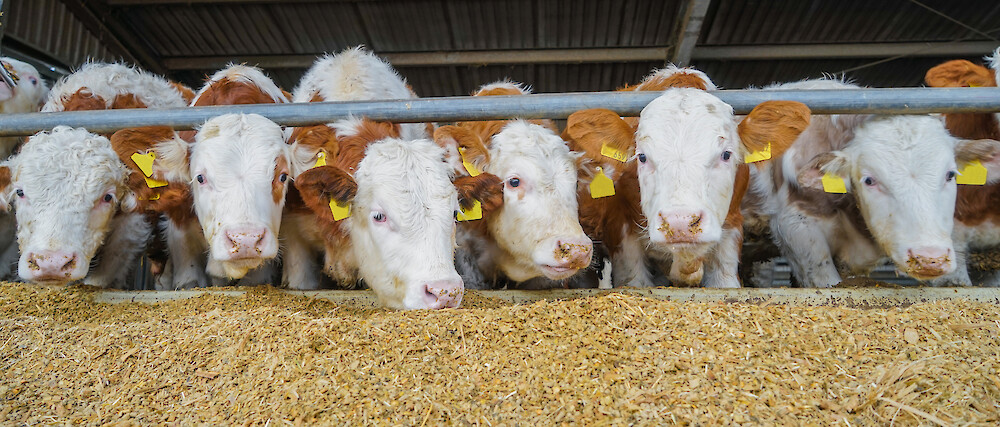Sensible supplementation of the ration for a needs-based supply
Urea use in the feeding of dairy cattle and bulls - sensible and animal-friendly?
Grass silage low in crude protein with a high sugar content, starchy maize silage and the use of the farm's own grain require high amounts of protein supplements in the rations. Especially at high price levels on the protein market, it is important to optimise the ration fed. Priority is given to supplying dairy cattle and bulls in a way that is appropriate for the animals and their performance. Nevertheless, profitability is also a factor that should be kept in mind. The use of urea can be helpful here and should be examined by every farm.
Additional nitrogen for valuable microbial protein in cattle through urea
Urea is a non-protein nitrogen (NPN) compound. With a proportion of >45 % nitrogen (N), urea is suitable for optimising the supply of rumen-available nitrogen to beef c attle and dairy cows. In the rumen, urea is quickly and completely degraded to ammonia (NH3). If energy (sugar, starch) and minerals are also available there in sufficient quantities, the NH3 is built up by the rumen microbes into valuable microbial protein with all the important essential amino acids. These are then available to the animals in the small intestine.
Urea: natural component of protein metabolism
Cattle break down non-rumen-stable protein fractions in the rumen to NH3. In addition to building up microbial protein, up to 500 g of urea is synthesised daily in the liver to detoxify excess NH3. Some of this then returns to the rumen via the saliva, where it is again available for microbial protein synthesis. In contrast to monogastrics, which excrete excess nitrogen exclusively through urine, ruminants can thus recycle some of the nitrogen. This process is also called the ruminohepatic cycle or rumen-liver cycle. Urea is thus a natural, endogenous component of protein metabolism in ruminants.
Consequences of a lack of microbially available nitrogen
If the nitrogen supply of the microorganisms cannot be ensured, there is a risk of a corresponding deficiency. This causes a slowdown in microbial activity, wastes potential in microbial protein synthesis and causes poorer utilisation of energy components. An undersupply of NH3 is manifested by the occurrence of one or more of the following symptoms:
- undigested components in the faeces (e.g. starch components from maize silage)
- solid faeces
- reduced passage rate in the rumen
- Reduction of the daily feed intake

Urea as an ingredient for balancing low-protein rations
The use of mixtures with urea is suitable for balancing low-protein rations. These include, for example, rations with a medium to high proportion of maize silage, cereals or low-protein but high-sugargrass silage. When feeding these rations, a sufficient NH3 supply of the microorganisms in the rumen can often only be ensured with added feed urea. For this reason, mixtures with urea are also excellently suited for bulls, as bull rations contain a lot or exclusively maize silage as basic feed.
In contrast, staple feeds with a lot of soluble nitrogen are less suitable for the use of urea. If, for example, wet grass silage is fed, urea should not be used or only in small quantities.
Ration calculation: basis for the use of feed urea
A prerequisite for the successful use of urea is the implementation of a ration calculation. Only if the use of urea is optimally adapted to the total ration and well synchronised with the other components of the ration can the best possible positive effects be achieved. When calculating the ration, it must also be taken into account that high-performance cows not only have a high nitrogen requirement in the rumen, but also need a particularly high amount of rumen-stable protein (UDP), usable crude protein at the duodenum (nXP) and amino acids available in the small intestine. Urea is only approved for the supply of animals with a developed rumen.
Urea rounds off protein supplements in a sensible way
Because of its importance in protein metabolism, urea is used above all in versatile protein supplements. Here, together with - protected, unprotected, slow and medium-fast - protein components as well as energy carriers of different degradation rates, it forms the basis for ideal rumen synchronisation and thus ensures optimal digestion. Urea can be optimally and evenly dosed via mixed feed. If urea is fed via protein supplements, there is also no obligation to report and record it. Information on the amount of urea in the feed is shown in the declaration (see info box).
This is how urea is declared in compound feeds
On the feed declaration, urea is found among the additives. The information is given in milligrams per kilogram (mg/kg). 20.000 mg/kg, for example, corresponds to 2 % urea. In addition, other relevant information such as "crude protein from NPN" (non-protein nitrogen compounds) can be found here. For example, a protein supplement with 2 % urea contains 5.7 % crude protein from NPN.
Calculation: Urea contains 45.6% nitrogen (N) x 6.25 (conversion factor from N to crude protein). This results in 285 g crude protein x 2 % urea divided by 100 = 5.7 % crude protein from NPN compounds.

If possible, add urea via a mixed feed
A uniform administration of urea to ensure a continuous uptake by the animal throughout the day is a basic prerequisite for the use of urea. Farmers therefore have to check the mixing accuracy in the ration exactly, which is very difficult when using urea in pure form. Since feed urea is water-soluble, it must also be stored in a dry place. Because of this, feeding urea as part of a protein supplement is much easier and more accurate.
When farmers start using urea for the first time, they should allow for a blending phase of one to two weeks, as rumen microbes only get used to new components in the ration slowly. During this time, the proportion should be increased continuously until the desired amount is reached.
Recommendations for the feeding of urea
|
Direction of use |
Recommendation for use |
Legal maximum content |
|
Dairy cows (animals with developed rumen) |
Up to 0.5 % of the total feed DM or 15 g / 100 kg LG |
10 g / kg DM and a maximum of 30 % of the total nitrogen of the ration from urea |
|
Cattle for fattening (from 200 kg) |
Up to 0.5 % of the total feed DM or 15 g / 100 kg LG |
Source: From: "Merkblatt Harnstoff" of the Bavarian State Research Centre for Agriculture of the Institute for Animal Nutrition and Feed Management (as of January 2021).
Important: When using Urea the specified quantities must be adhered to.
Registration obligation for the use of urea in pure form
If urea is used "pure" and added to the ration, it is considered an additive. Therefore, it must be registered accordingly (EC Regulation No. 183/2005). This means that the use of urea must be reported to the competent feed monitoring authority. In addition, farmers must provide the authorities with detailed records of the feed according to HACCP (Hazard Analysis and Critical Control Points). An exemplary template can be found in the "Merkblatt Harnstoff" (leafletonurea) of the Bayerische Landesanstalt für Landwirtschaft (Bavarian State Research Centre for Agriculture) of the Institut für Tierernährung und Futterwirtschaft (Institute for Animal Nutrition and Feed Management) (as of January 2021). Please note that other federal states (sometimes) have different requirements.
Conclusion
- Urea is a natural, endogenous component of protein metabolism in ruminants.
- Feed urea should only be fed together with easily digestible carbohydrates(sugar, cereal and maize silage starch).
- Almost all rations can be optimised by using appropriate urea additions. Rations with a high proportion of soluble nitrogen (e.g. wet grass silage) are an exception.
- The basis for the use of urea is a ration calculation.
- Farmers should follow recommendations and guidelines for dosage and handling in order to achieve an optimal result.
Further information
- "Merkblatt Harnstoff" incl. protocol sheet (as at: January 2021) of the Bavarian State Research Centre for Agriculture of the Institute for Animal Nutrition and Feed Management.
- "Merkblattfür den Einsatz von Futtermittel-Zusatzstoffen im landwirtschaftlichen Betrieb" (as of October 2013) by the Central Committee of German Agriculture (ZDL).
Image sources (top slider): © Countrypixel - stock.adobe.com / © Mulderphoto - stock.adobe.com



























